Grow tents have revolutionized the indoor farming industry by offering a highly efficient and manageable micro-environment for growing various plants, such as cannabis, marijuana, strawberries, leafy greens, tomatoes, etc. They allow you to control all critical aspects of the growing environment, including temperature, humidity, light intensity, and air circulation, which are crucial for plant growth.
Grow tents are responsive to different growing needs since indoor plants have different growing requirements. For instance, some plants, like orchids and ferns, thrive in high-humidity conditions, while cacti and succulents prefer a dry environment.
Grow tents come in various sizes, shapes, heights, weight limits, structures, and materials to meet these diverse needs. Some are small enough for a countertop (2×2, 2×4 ft), while others are large enough to fill a garage (8×8, 10×10 ft). There are also multi-chamber grow tents that allow you to grow plants at different stages of development.
When choosing the best grow tents, consider size, material, ventilation, durability, ease of use and installation, and price points. These factors ensure high-quality grow tents and provide more extended use regardless of external conditions. The stronger the materials, the more reliable construction they provide for plants, and the size matches the larger number of plants growers can grow inside the tents.
Table of Contents
- What is a Grow Tent?
- 7 Types of Grow Tents
- 5 Factors to Consider When Choosing a Grow Tent
- What Parts Make Up a Grow Tent?
- What Are Must-Have Grow Tent Accessories?
- Is It Illegal to Own a Grow Tent?
- Grow Tents vs. Grow Rooms: Which is Better?
- Grow Tents vs. Grow Boxes (Cabinets): Which is Better?
- What is the Difference Between a Grow Tent and a Greenhouse?
- Do Grow Tents Use a Lot of Electricity?
- What Can You Grow in a Grow Tent?
- Where to Buy a Grow Tent?
What is a Grow Tent?
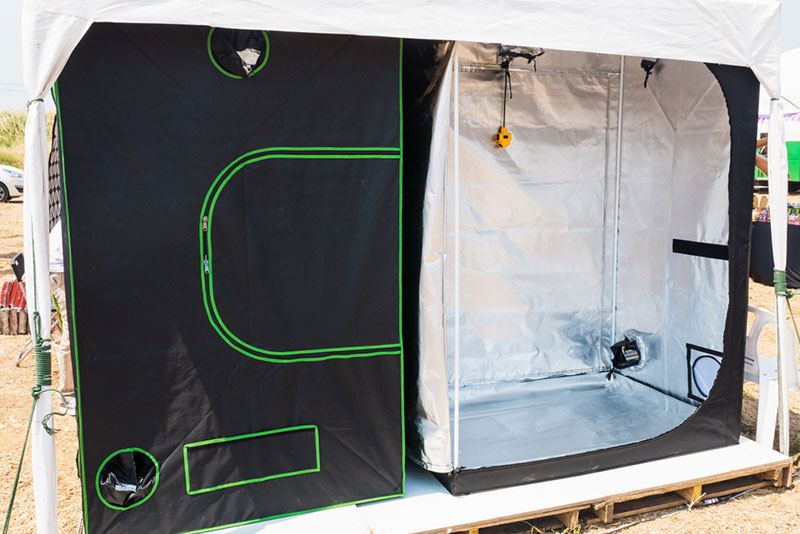
A grow tent is a portable, reusable grow room with a sturdy canvas exterior, providing an enclosed space for growing plants in controlled conditions. The interior of a grow tent is reflective to maximize light efficiency.
The main difference lies in their purpose and design compared to other common tents. Regular tents are designed for camping or outdoor activities, while grow tents are specifically designed for indoor gardening.
A grow tent frame is typically constructed from strong, often metal materials to support the weight of various equipment like grow lights, ventilation systems, and indoor growing plants.
The cover of a grow tent consists of two parts: the inner and outer parts. The inner layer is highly reflective, designed to maximize and evenly distribute light, preventing any light leakage and ensuring the plants get the most out of your grow lights. The outer layer is usually made of thick, durable fabric to protect against external factors and keep the grow light contained within the tent.
Grow tents come with built-in ventilation ports for duct fans and carbon filters. Duct fans help to maintain an appropriate temperature by removing hot air, while carbon filters cleanse the air of any unwanted smells or potential contaminants, ensuring a steady supply of fresh air for the plants.
Grow tents create an ideal, contained environment for indoor plant growth. They control light, humidity, and temperature, which are essential for plant growth. The reflective interior maximizes light exposure to the indoor growing plants, the ventilation system regulates temperature and airflow, and the contained environment allows for humidity control.
What Are the Benefits of Grow Tents?
When comparing why you should use a grow tent instead of just growing plants outside, the main difference is that an indoor grow tent allows you more control of growing conditions, such as humidity, temperature, pests, etc.
The outdoor gardening plants require no initial setup costs, with abundant natural sunlight and rainwater. However, growing plants outdoors doesn’t have complete control over environmental factors such as external temperature changes, light exposure, and humidity. They are vulnerable to pests, diseases, and adverse weather conditions and are limited by seasons and climate conditions.
On the other hand, the main benefits of the indoor grow room include total control of the growing environment, avoiding pests and infestations, energy efficiency, versatility and adaptability, maximizing space, garden year-round, and odor protection.
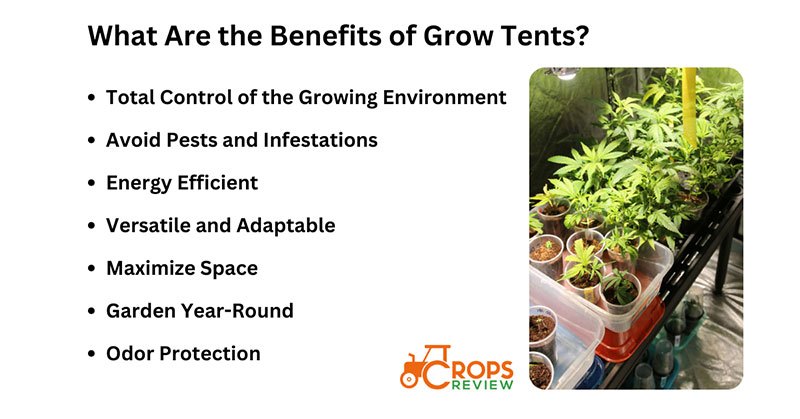
Total Control of the Growing Environment: You can control all crucial factors such as temperature, light intensity, humidity, and ventilation in a grow tent, leading to more robust and healthier plants and higher yields.
Avoid Pests and Infestations: A grow tent’s enclosed environment helps protect your plants from pests and diseases inside, reducing the need for chemical insecticides or pesticides.
Energy Efficient: Grow tents are designed to optimize lighting. The reflective interior ensures that light is distributed evenly, maximizing photosynthesis and reducing energy costs.
Versatile and Adaptable: Grow tents come in various sizes (2×21 x4x4, 6×6, 8×8, 10×10, etc.) and can be set up almost anywhere, making them adaptable to your space and needs. They’re also easy to assemble and disassemble.
Maximize Space: The compact design of a grow tent allows you to make the most of any space, no matter how small. It also keeps your growing operation neatly contained.
Garden Year-Round: With a grow tent, you’re not limited by seasons or weather conditions. You can grow more plants at any time of the year.
Odor Protection: Grow tents come with carbon filters, which help to control odors. The odor protection is particularly useful when growing plants with strong scents, including cannabis and marijuana.
However, compared to outdoor growing conditions, growing plants indoors has a higher initial cost for setup, including the grow tent, grow lights, fans, and other equipment inside, such as humidity controllers, CO2 monitors and tanks, etc.
A grow tent also requires regular monitoring and adjustment of environmental conditions, including keeping the temperature at optimal levels (70-85°F/21-30°C), humidity levels between 45-75%, and CO2 at 1200-1500 PPM.
Energy costs are also higher than outdoor gardening due to electrically powered lights and fans.
7 Types of Grow Tents
Different grow tents depend on factors such as size, height, ventilation system, lighting system, etc, and based on such criteria, you must choose a grow tent to meet your growing needs.
For instance, grow tents come in various sizes, from small (2’x2′) to large (10’x20′). Small grow tents are perfect for hobby growers who just want to grow a few plants, such as herbs, lettuce, mushrooms, etc., while larger ones accommodate commercial growing operations, including marijuana and cannabis, fruits, and vegetables.
The height of the grow tent is also crucial. Taller grow tents (6′ or more) are suitable for taller plants, including money trees, lady palms, ficus tineke, or tomatoes, or those using training techniques like trellising. Shorter grow tents are more suitable for smaller plants such as herbs or leafy greens or if you have limited ceiling height.
Grow tents come with built-in lighting systems. These are categorized into LED, HID, or Fluorescent grow lights. The type of light system you need will depend on the plant species you’re growing and their light requirements. For example, succulents and fruiting vegetables often require high-intensity light, making LED or HID systems a good choice.
Based on such factors, there are 7 main types of indoor grow tents, including grow tent kits, single-chamber grow tents, multi-chamber grow tents, box-style grow tents, grow cabinets and grow boxes, commercial-grade grow tents, and mini grow tents.
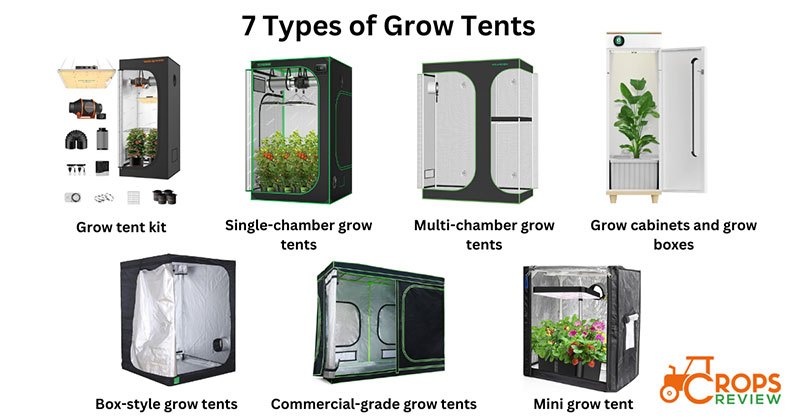
1. Grow Tent Kit
A grow tent kit is a complete package that includes all the necessary equipment to create an indoor garden, such as a grow tent, a lighting system, ventilation equipment, and other accessories like thermometers, timers, and plant nutrients. Grow tent kits also include hydroponic systems for soilless growing.
A grow tent kit creates a controlled environment for plants to grow indoors. The tent acts as a miniature greenhouse, trapping light and heat to create ideal growing conditions. The lighting system provides the light needed for photosynthesis, while the ventilation system helps regulate temperature and humidity levels. Other accessories can further help control the growing environment and promote healthy plant growth. For instance, a CO2 monitor regulates the optimal levels of the plants inside to prevent decay and accidents.
Grow tent kits offer several competitive advantages, including convenience, cost-effectiveness, and compatibility in terms of purchasing choices. A grow tent kit provides all the necessary equipment in one package, making setup quick and easy. Buying a grow tent kit is often cheaper than buying each component separately. All the components in a grow tent kit are designed to work together, ensuring compatibility and optimal performance.
The popularity of grow tent kits has been growing, especially among urban dwellers and those without access to outdoor gardening space. Regardless of weather or space constraints, they allow anyone to grow their plants. The rise of homegrown food and medicinal cannabis has also driven demand for these kits. For this reason, they are ideal for beginners, experienced gardeners, and anyone interested in year-round gardening.
However, even the best grow tent kits have their advantages and disadvantages, listed below:
- Convenient and easy to set up.
- Provides a controlled environment for optimal plant growth.
- It can be used to grow plants year-round.
- Saves money by bundling necessary equipment together.
- Quality varies as grow tent kits offer subpar lighting or ventilation systems.
- It may offer more than what a beginner gardener needs.
- It takes up indoor space and may not be suitable for small apartments.
- Requires electricity to run, which adds to energy bills.
2. Single-Chamber Grow Tents
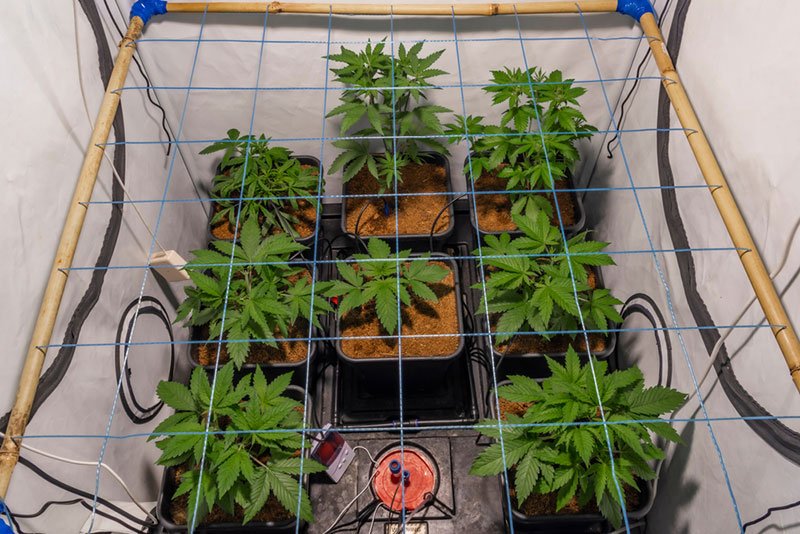
A single-chamber grow tent is an indoor gardening setup with one main area for growing plants. Unlike multi-chamber or 2 in 1 grow tents, these tents do not have separate sections for different growth stages. They are suitable for growing plants at the same stage of development.
A single-chamber grow tent provides a controlled environment for plants to grow in. The tent is typically equipped with reflective material on the inside to maximize light efficiency, and it can be fitted with a lighting system, ventilation, and other equipment needed for an indoor garden. Since there’s only one chamber, all plants within the tent are subject to the same light cycle and environmental conditions.
Single-chamber grow tents have several competitive advantages, such as simplicity, flexibility, and cost-effectiveness. They are simpler to set up and manage than multi-chamber tents, making them ideal for beginners. They allow for more flexibility in terms of plant arrangement and equipment setup. They are typically cheaper than multi-chamber tents due to their simpler design.
Single-chamber grow tents are popular among indoor gardeners due to their simplicity and affordability.
When purchasing the best single-chamber grow tent, consider the pros and cons given below:
- Simplicity and ease of use.
- More flexibility in plant arrangement and equipment setup.
- Typically cheaper than multi-chamber tents.
- It is less efficient for continuous harvesting as plants are all at the same stage.
- It is unsuitable for plants requiring different environmental conditions, including tomatoes, cannabis, peppers, lettuce, orchids, etc.
- Less control over individual plant development compared to multi-chamber tents.
3. Multi-Chamber Grow Tents
A multi-chamber grow tent, also known as a 2-in-1 or 3-in-1 grow tent, is an indoor growing system with separate sections or “chambers” for different stages of plant growth. These tents typically have a larger main area for mature plants and one or two smaller areas for small plants – seedlings or young plants. They allow you to have plants at different life stages growing simultaneously in the same tent.
Multi-chamber grow tents provide individual, controlled environments for plants at different stages of growth. For example, one smaller chamber may be used for seedlings and clones, while another for flowering plants and fruiting stages. Each chamber has lighting, temperature, and humidity settings, allowing you to optimize conditions for each growth stage.
Multi-chamber grow tents offer several competitive advantages, such as versatility, space-saving, efficiency, and control. They allow for multiple stages of plant growth within the same tent. Their compact design makes efficient use of space, ideal for indoor gardeners with limited room. These tents enable continuous harvesting cycles by moving plants between chambers as they mature. They provide more control over individual plant environments. The tents are especially popular among indoor growers who want to maximize their yield within a limited space.
If you want the best multi-chamber grow tents, refer to their advantages and disadvantages below:
- Allows for multiple stages of growth within the same tent.
- Enables continuous harvest cycles.
- Efficient use of space
- Provides more control over individual plant environments.
- Optimizes use of space and resources.
- It is more complex to set up and manage than single chamber tents.It is more complex to set up and manage than single chamber tents.
- It may be more expensive due to the additional equipment needed for each chamber.
- It is unsuitable for large plants that need much space, like fruits, vegetables, or trees.
- Less sturdy construction or lower quality materials than traditional grow tents.
4. Box-style Grow Tents
A box-style grow tent, also known as a grow box, is a self-contained indoor growing environment that resembles a box or cabinet. It’s designed to create optimal conditions for plant growth, typically equipped with a light source, ventilation system, and often includes hydroponic systems.
A box-style grow tent provides a controlled environment for plants to grow in. The walls are usually lined with reflective material to maximize light efficiency, and the tent can be fitted with light coverage, ventilation, and additional equipment, such as controllers and monitors needed for indoor gardening. Grow boxes also include hydroponic systems, allowing plants to grow in water-based solutions instead of soil.
Box-style grow tents are known for their space efficiency, all-in-one solution design, and stealth. They are compact and designed to fit into small spaces, making them ideal for indoor gardeners with limited space. Grow boxes have all the necessary growing equipment, making them a convenient all-in-one solution. Their cabinet-like appearance makes them less conspicuous than traditional grow tents, which can benefit those who prefer a discreet setup.
Box-style grow tents are popular among indoor gardeners who value convenience, space efficiency, and discretion.
To pick the best box-style grow tents, refer to their pros and cons given below:
- Compact and space-efficient.
- It often comes as an all-in-one solution with all necessary equipment included.
- Discreet design that can blend in with home decor.
- Limited space might not be suitable for larger plants or multiple plant species.
- There is less flexibility in terms of equipment setup compared to traditional grow tents.
- It may be more expensive due to the inclusion of all necessary equipment.
5. Grow Cabinets and Grow Boxes
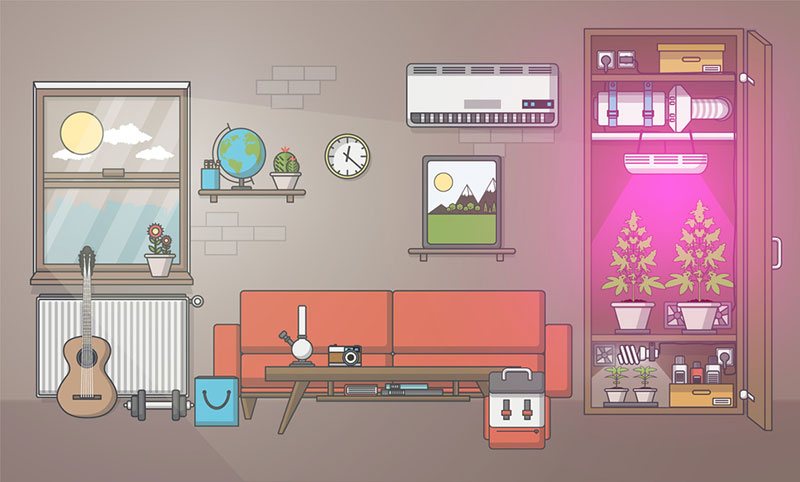
Grow cabinets and grow boxes, also known as stealth grow cabinets or boxes, are self-contained indoor gardening systems that resemble furniture or appliances. They offer a discreet, space-efficient, and controlled environment for growing plants indoors.
Grow cabinets and boxes work by providing a fully enclosed, climate-controlled environment for plants. They often come equipped with lighting, ventilation, and even hydroponic systems. The interior walls are typically lined with reflective material to maximize light exposure, and the enclosed design helps maintain optimal temperature and humidity levels.
Grow cabinets and grow boxes offer various competitive advantages, including discreet, all-in-one solutions in space-efficient design. Their furniture-like appearance makes them blend seamlessly into home decor, offering a more discreet option for an indoor garden. grow cabinets and boxes come equipped with all necessary components (lights, fans, filters, etc.), making them a convenient all-in-one solution. Their compact design makes them ideal for indoor gardeners with limited space.
Grow cabinets and boxes are popular among indoor gardeners who prefer a discreet, space-saving solution. They’re especially favored by those living in apartments or small spaces or beginners who want an easy-to-use, complete growing system.
To find the best grow cabinets and boxes, consider the advantages and disadvantages listed below:
- Discreet and blend into home decor.
- All-in-one solution with all necessary components included.
- Space-efficient, ideal for small spaces.
- Controlled environment for optimal plant growth.
- Limited space may be unsuitable for larger plants or growing multiple plant species such as vegetables or fruit trees.
- Due to their all-inclusive nature, it can be more expensive than DIY or traditional grow tent setups.
- There is less flexibility in customizing the setup compared to traditional grow tents.
6. Commercial-Grade Grow Tents
Commercial-grade grow tents are larger, more robust versions of standard grow tents designed to cater to the needs of commercial growers. They are built with high-quality materials and often include heavy-duty frames, industrial-grade zippers, thick fabric, and infrared-blocking roofs to ensure durability and optimal growing conditions.
Commercial-grade grow tents work the same way as standard grow tents by providing an enclosed, controlled environment for plants. However, they are typically larger and more durable to accommodate a greater number of plants and withstand the rigors of commercial use. They have reflective interiors to maximize light efficiency and are often equipped with ventilation systems and ports for electrical cables.
The main competitive advantages of commercial grow tents include durability, capacity, and versatility. They are built with high-quality materials to withstand commercial use. They are larger than standard grow tents, allowing for more plants. They offer adjustable height settings and multiple access points for ease of use.
Commercial-grade grow tents are popular among commercial growers and serious hobbyists who require a large, durable indoor growing space.
When you want the best commercial-grade grow tents, search for their advantages and disadvantages given below:
- Durable and built to withstand commercial use.
- Large size allows for a greater number of plants.
- Adjustable height settings and multiple access points.
- It is more expensive than standard grow tents.
- They require more space due to their larger size.
- It may be too large or complex for beginners or those with limited space.
7. Mini Grow Tent
A mini grow tent is a small, portable version of a standard grow tent designed for indoor gardening in a compact space. It provides a controlled plant environment, featuring reflective interiors, ventilation ports, and a built-in lighting system.
A mini grow tent encloses a small space where plants can grow in a controlled environment. The reflective interior walls are lined with high-quality material to maximize light exposure, aiding plant growth. The tent also often includes ventilation systems and ports for electrical cables. Mini tents have light coverage, but you can also purchase them separately.
Mini grow tents have several competitive advantages, including space efficiency, portability, and affordability. Their compact size makes them ideal for small spaces or for those who want to experiment with indoor gardening without investing in a larger setup. Mini grow tents are usually lightweight and easy to assemble, disassemble, and move around. Due to their smaller size, mini grow tents are typically more affordable than larger ones.
Mini-grow tents are popular among indoor gardeners with limited space or those who want to experiment with indoor gardening without committing to a larger setup. They’re also favored by those who want to grow several plants indoors.
To find the best mini grow tent for your indoor hydroponic garden, consider their advantages and disadvantages presented below:
- Compact and space-efficient, ideal for small spaces.
- Portable and easy to move around.
- Typically more affordable than larger grow tents.
- Offers a controlled environment for optimal plant growth.
- Limited space might be unsuitable for larger plants or multiple plant species like fruits and vegetables.
- It may lack some features of larger grow tents, such as adjustable height settings.
- If not included, it may require additional purchases, such as lighting systems.
5 Factors to Consider When Choosing a Grow Tent
To choose the best grow tent, consider factors like grow tent brand, grow tent size, grow space, grow tent material, grow tent construction, and type of plants, as these elements determine the tent’s durability, suitability for your plants, ability to maintain optimal growing conditions, and effectiveness in promoting healthy plant growth.
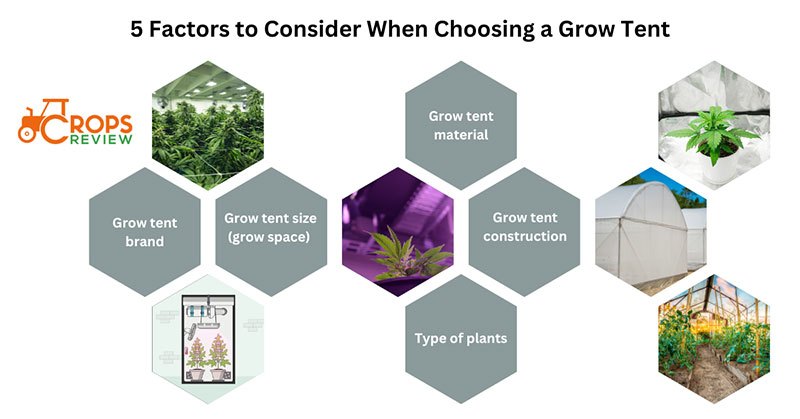
1. Grow Tent Brand
The brand of a grow tent can significantly impact its quality, durability, ease of installation, and usability. Established brands often invest in research and development to ensure their products meet the needs of growers. They use high-quality materials for durability and design their tents for easy installation and use. Brands in the market for a while also tend to have better customer service and more reliable warranties.
To choose the best grow tent brands, consider quality vs. price, warranty, customer service, and features.
Look into each brand’s reputation, read reviews, and compare their products. More expensive doesn’t always mean better. Consider the materials’ quality and whether the price matches the value offered.
Good brands usually offer warranties and have responsive customer service. Check the terms of the warranty and whether the company is known for honoring it.
Consider what features are important to you, such as size, height adjustability, number of ventilation ports, etc., and see which brand offers those in your price range.
You can choose among the most popular grow tent brands and find the most fitting one easily:
- Vivosun: Known for its overall quality and value, Vivosun offers a range of sizes and configurations. Their tents are praised for their durability and ease of assembly.
- AC Infinity: AC Infinity is recognized for the “Advance Grow System,” which is a premium product. They focus on innovative designs with smart technology to optimize plant growth.
- Mars Hydro: Mars Hydro is popular for offering good quality at an affordable price point, as mentioned by Reddit users. They are also known for their excellent lighting systems.
- Gorilla Grow Tent: Gorilla Grow Tent stands out for its high-quality, durable grow tents. Gorilla grow tents offer a variety of sizes, and their tents are known for superior strength.
- Spider Farmer: Spider Farmer provides pro-grade, highly durable tents for growing. They stand out for their robust construction and reflective interiors.
- iPower: iPower is noted for its budget-friendly options without compromising on quality. They offer a variety of sizes and configurations.
- Quictent: Quictent offers eco-friendly, non-toxic grow tents. They are SGS-approved and are known for their safety standards.
- Giantex: Giantex provides a range of grow tents suitable for various needs. They are known for their good balance between price and quality.
- CoolGrows: CoolGrows had the most consistent reviews on Reddit. They are known for their well-constructed and reasonably priced grow tents.
- Zazzy: Zazzy offers a range of grow tents that are praised for their durability and affordability. They offer various sizes to cater to different growing needs.
- Opulent Systems: Opulent Systems offers high-quality grow tents that are easy to assemble. They’re known for their excellent customer service.
- Castle Greens: Castle Greens is praised for its high-quality materials and sturdy construction. They offer a variety of sizes to cater to different growing needs.
- GrowBuds: GrowBuds offers premium grow tents that are well-constructed and highly durable. They also provide excellent customer service.
2. Grow Tent Size (Grow Space)
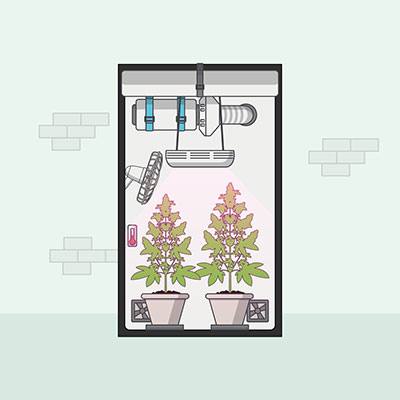
The term “grow space” refers to the amount of room inside a grow tent allocated for plant growth. It’s the area you have available for your plants to grow in, considering the space needed for equipment like lights, fans, and filters.
A good grow space provides enough room for your plants to grow without overcrowding while accommodating all necessary growing equipment.
The best grow tent sizes and plant count depend on several factors, including the type of plants you’re growing, their mature size, and the amount of space each plant requires.
The size of the grow tent you need depends on what type of plants you’re growing and how many. For instance, small plants like herbs, and lettuce need a small tent around 2×2 feet or 2×4 feet. Medium plants like peppers, and dwarf tomato plants require a medium-sized tent around 3×3 feet or 4×4 feet. Large plants like full-sized tomato plants and cannabis need a tent around 4×8 feet or larger.
Consider the mature size of the plants you’re growing, as some plants need more space than others, like fruit trees or vegetables, or if you grow marijuana or cannabis. For instance, cannabis needs 3-4 square feet, tomatoes need 2-3 square feet, and clementine needs 2-4 square feet.
To choose the right grow tent sizes, measure your grow space. Measure the length, width, and height of the room where you plan to place your grow tent. Don’t forget to account for the space your equipment will take up. Remember vertical space. Plants like fruits, flowers, and vegetables grow tall and will need plenty of room to stretch up. Ensure the tent size can accommodate proper ventilation systems to maintain air quality. If you plan to expand your operation in the future, it might be worth investing in a larger tent now.
3. Grow Tent Material
The material of a grow tent plays a significant role in its durability, efficiency, and productivity. A good grow tent with high-quality materials such as nylon or polyester enhances its effectiveness, as these materials are waterproof when coated, support the outer construction, and are durable enough to withstand weather conditions.
For instance, tents made from Mylar are highly reflective, improving light distribution. It’s also flexible and easy to install on the walls of the grow tent frame.
Thicker materials such as heavy-duty canvas or polyethylene terephthalate resist wear and tear, providing better insulation from heat and noise as they have D ratings for thickness from 200D to 1680D. Heavy-duty zippers and metal frame poles also contribute to a tent’s durability.
Finally, these durable, lightweight materials can make the tent easier to install. Easy-to-clean materials simplify maintenance.
Several types of materials are commonly used in grow tents, such as mylar, oxford cloth, canvas, polyvinyl chloride – PVC, and metal. Mylar is a highly reflective material that maximizes light distribution within the tent. A grow tent with a Mylar interior is generally recommended for its high reflectivity and to improve plant growth. Oxford Cloth is a durable fabric often used for the tent’s exterior. Canvas is another durable option that can withstand wear and tear. Polyvinyl Chloride is used for the support structure, but not as durable or environmentally friendly as metal. Metal is often used for the frame due to its strength and durability.
To choose the ideal grow tent material, look for a tent with a highly reflective interior to maximize light efficiency. Choose a tent made from durable materials to withstand wear and tear. Opt for materials that are easy to clean to simplify maintenance.
Consider the environmental impact of the materials. For example, metal frames are generally more eco-friendly than PVC. Thicker materials provide better insulation for heat and noise.
4. Grow Tent Construction
The construction of a grow tent significantly impacts its usability and longevity. High-quality construction ensures that the grow tent is sturdy, able to support the weight of your plants and equipment, and properly sealed to prevent light leaks so plants grow healthily. A poorly constructed tent could lead to issues like light leaks, difficulty maintaining temperature and humidity levels, and even damage to your plants or equipment.
Tents with robust frames, strong connectors, and heavy-duty zippers last longer. The way the tent is constructed also affects its resistance to wear and tear.
Features like removable floors for easy cleaning, multiple access points for convenient maintenance, and adjustable vent sizes for flexible ventilation options can make a grow tent easier to use and install.
The best grow tent construction for you depends on your specific needs. If you’re a beginner or have limited space, a simple design made of steel or aluminum with easy assembly might be best. If you’re an experienced grower with larger plants or more equipment, a sturdy frame made of powder-coated steel with multiple access points is more suitable.
When choosing the grow tent construction, ensure the tent fits comfortably in your available space, with room for ventilation and equipment.
Consider the size and number of plants you’ll be growing. Larger or more numerous plants such as flowers, fruits, or vegetables need a sturdier frame.
Look for strong, rigid materials like steel, aluminum, or metal for a well-constructed frame for the strongest tents.
Removable floors, adjustable vents, and multiple doors make maintenance easier for a good tent.
5. Type of Plants
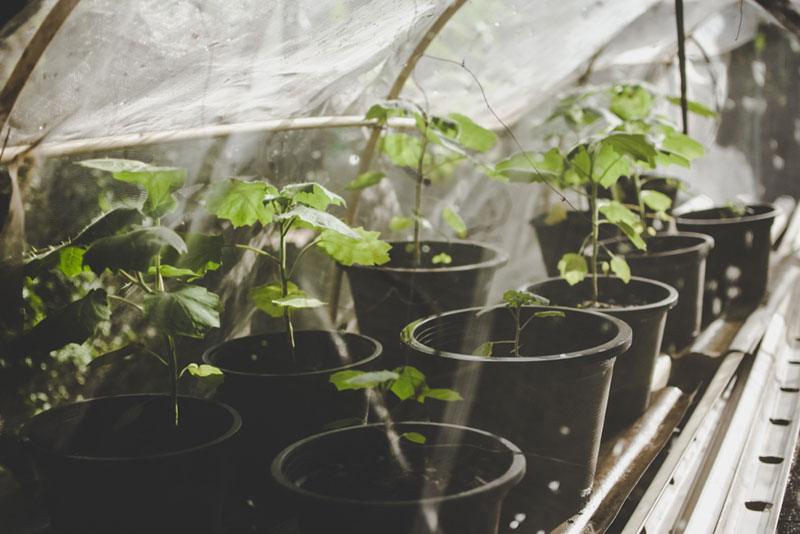
Different types of plants grown in grow tents will require different growing conditions, leading to the need for different types of grow tents. For instance, some plants like cannabis, peeper, orchids, or cannabis need more light than others, such as strawberries or green leafs.
Larger, heavier plants such as cucumbers, tomatoes, peppers, orchids require a more robust support system, which could strain your grow tent’s frame.
The type of plant can affect the setup of your grow tent. Some plants require additional equipment, such as trellises or stakes, including cannabis, orchids, and tomatoes.
Some plants are easier to care for than others. For example, basil, cannabis, and tomatoes require frequent watering, pruning, or specific lighting schedules, while strawberries don’t.
There are countless plants you could grow in a grow tent. Some popular options include vegetables such as tomatoes, peppers, lettuce, cucumbers, etc; herbs like basil, mint, oregano, and rosemary; fruits such as strawberries, and blueberries, etc; flowers including orchids, roses, violets, etc; and cannabis with various strains of marijuana.
The best type of plant for you to grow depends on your personal preferences and the legal restrictions in your area. Consider what you hope to achieve from your indoor garden: fresh veggies for cooking, herbs for tea, flowers for aesthetics, or cannabis for medicinal or recreational use.
To understand the plant types better and choose the best types for you
- Research plant requirements first. Understand the specific needs of the plants you want to grow in terms of light, temperature, humidity, and space.
- Consider your space, as larger plants will need more room to grow vertically and horizontally.
- Plan for maintenance since some plants like cannabis, tomatoes, orchids require more care than others. Make sure you’re ready for the commitments.
- Check legal restrictions if you’re considering growing cannabis to make sure it’s legal in your area.
What Parts Make Up a Grow Tent?
The parts that make up a grow tent include the structure, fabric, reflective materials, opening and vets, zips, and fabric tray.
Structure: The structure, often made from metal or plastic poles, forms the skeleton of the grow tent. It provides support and shape to the tent, ensuring it stands upright and can support the weight of lights, fans, and other equipment such as controllers, monitors, tanks, etc.
Fabric: This is the outer shell of the grow tent. It’s typically made from a heavy-duty, light-proof material to prevent light leaks. The fabric also helps to contain odors, noise, and pests and aids in temperature and humidity control.
Reflective Materials: The inside of the grow tent is lined with reflective material to maximize light efficiency. It ensures that light is evenly distributed around the plants, reducing energy waste and promoting healthier plant growth.
Openings and Vents: They are used for ventilation, cable access, and observation. Ventilation openings allow for the installation of fans or filters to control temperature and humidity. Cable openings ensure neat organization of wires, and observation windows allow you to inspect your plants without disturbing the internal environment.
Zips: Zips provide access to the interior of the grow tent. High-quality zippers are essential for durability and to prevent light leaks. Grow tents also feature multiple zippered openings for easy access to all areas of the tent.
Fabric Tray: Also known as a floor tray, this is placed at the bottom of the grow tent. It’s waterproof and used to catch any water or soil that may fall during watering or maintenance. It keeps the tent clean and makes it easier to manage any spills.
What Are Must-Have Grow Tent Accessories?
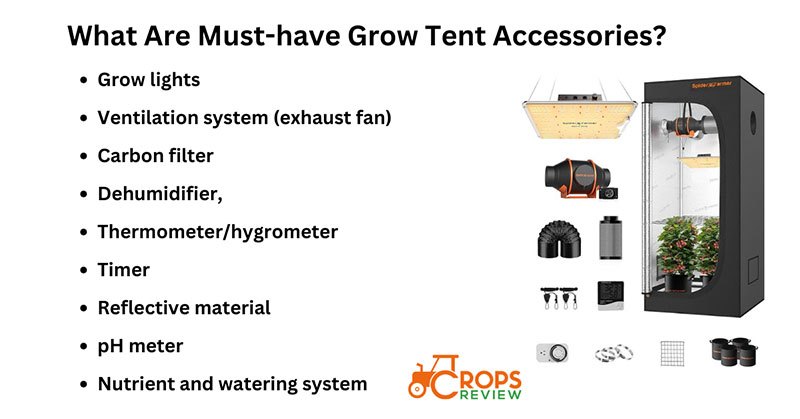
The must-have grow tent accessories include grow lights, a ventilation system (exhaust fan), a carbon filter, a dehumidifier, a thermometer/hygrometer, a timer, reflective material, a pH meter, nutrients, and a watering system.
Grow light is essential for any indoor garden as plants require light for photosynthesis. The type of light you choose (LED, HID, etc.) affects your plants’ growth speed and overall health.
The ventilation system (including an exhaust fan) is crucial in a grow tent to control temperature, remove excess moisture, and provide fresh air for your plants. This usually involves an exhaust fan and ducting.
A carbon filter is used with your ventilation system to eliminate odors from the grow tent. It’s especially important to grow plants with strong scents, such as cannabis.
A dehumidifier helps to control humidity levels within the grow tent. High humidity can lead to mold and other plant diseases. However, it should be used judiciously based on the specific needs of your plants and the existing humidity level, such as 50-70% for vegetative stages, 65-70% for seedlings, and 40-50% for flowering stages.
The thermometer/hygrometer measures temperature and humidity levels, respectively. Maintaining the correct temperature and humidity is crucial for optimal plant growth.
The timer automates your lighting schedule, ensuring your plants receive the correct light daily. It’s essential for controlling the vegetative and flowering stages of plant growth.
Often, the interior of a grow tent is made of a reflective material, but if not, you may want to add some. It helps to maximize the efficiency of your grow lights by reflecting light back onto your plants.
pH meter helps monitor the pH levels of your nutrient solution or soil. Different plants prefer different pH levels, such as cannabis 5.6-8.2 and tomatoes 4.3-4.9, and being off can hinder nutrient absorption.
Depending on the scale of your operation, you might need a more sophisticated watering and nutrient delivery system than just a watering can and manually adding nutrients. For instance, cannabis plants need 2.5-2.8 gallons of water per day for optimal growth.
Is It Illegal to Own a Grow Tent?
No, owning a grow tent itself is not illegal. Grow tents are tools that can be used for indoor gardening, such as growing vegetables, herbs, or flowers. However, the legality comes into question when they are used for growing cannabis where it’s not permitted by law. For instance, Massachusetts marijuana and cannabis law states that you can grow cannabis and marijuana for medical and recreational reasons, but you cannot sell them and use them openly. You must be at least 21 to grow the plants, and you cannot send it or use it in other states.
While grow tents themselves are not illegal, their use is often associated with the cultivation of cannabis, which is illegal in some parts of the U.S. and other countries. Therefore, even though you might use a grow tent for legal purposes, owning one may attract scrutiny from law enforcement, especially if you live in an area where cannabis cultivation is illegal, including Kansas, Iowa, Kentucky, and Louisiana, as the US News explains.
There are no specific laws governing the possession and use of grow tents. However, laws relating to the cultivation of cannabis do apply if you’re using the tent for this purpose. These laws vary from jurisdiction to jurisdiction, so check the local laws in your area.
If you use a grow tent to cultivate cannabis in a jurisdiction where it’s illegal, you could face serious consequences. These can range from fines to imprisonment, depending on the severity of the offense and the specific laws in your area. For instance, in Colorado, it’s considered a felony so you can pay a fine, or if you’re a high-schooler, you can be expelled or attend public service, education and intervention, loss of driving license, etc.
Can Grow Tents Go Outside?
Yes, grow tents can technically be set up outside, but they are primarily designed for indoor use. You might want to think twice about placing your grow tent outdoors, such as weather, temperature control, pests and diseases, security, and privacy.
Grow tents are not designed to withstand the elements like wind, rain, or snow as they damage the tent. Placing a grow tent outside makes it much more difficult to control the grow tent’s internal environment due to exposure to fluctuating outdoor temperatures.
While a grow tent can help protect plants from pests and diseases, placing it outdoors could increase the risk of these problems.
Placing tents outdoors draws unwanted attention and makes them accessible to others.
Grow Tents vs. Grow Rooms: Which is Better?
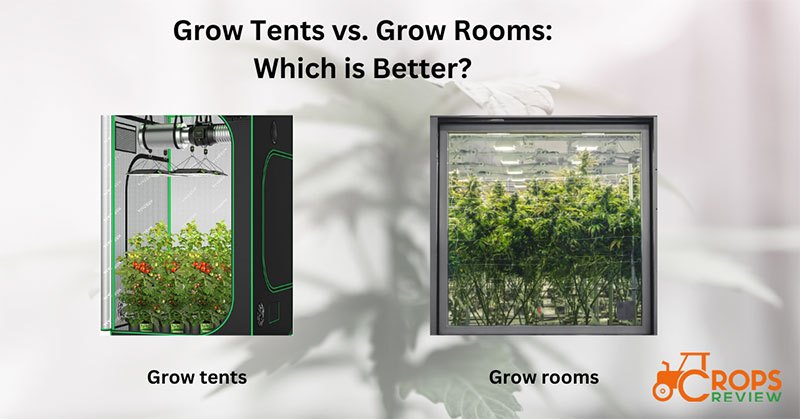
When choosing between a grow tent vs. a grow room, consider flexibility.
Grow tents allow you to set up an indoor garden virtually anywhere, using extra space in any room, which is beneficial if you can’t dedicate an entire room to indoor growing. However, grow rooms are more suitable for large-scale operations, often for commercial purposes, and offer more space, which allows for more plants and potentially higher yields.
Grow tents are generally more budget-friendly than building a dedicated grow room. For $1,000 or less, you can have a fully functioning grow tent.
Grow tents allow improved control over the growing environment, including light, water, temperature, and humidity. Their controlled environment contributes to healthier plant growth.
Suppose you are a hobbyist or small-scale grower with limited space and budget. In that case, a grow tent is a better choice due to its flexibility, affordability, and ease of control over the growing environment. However, a dedicated grow room is worth the investment if you’re planning a large-scale operation or commercial business due to the larger space and potential for higher yields.
Grow Tents vs. Grow Boxes (Cabinets): Which is Better?
Both grow tents and grow cabinets have unique advantages, but a grow tent is more beneficial due to its size and space. Grow tents tend to be more spacious than grow boxes, allowing for more plants to be grown simultaneously. They also accommodate larger ventilation and odor control equipment.
Grow tents are generally more affordable than grow boxes, making them a budget-friendly choice for indoor gardeners. Grow tents allow for a more cost-effective use of resources, as it’s easier to control the environment inside a tent. Grow tents are sealed, reducing the chances of a pest invasion. Grow tents are designed to maximize the space and efficiency of indoor gardens. Well-designed grow tents prevent any unwanted smell from escaping and keep light contained within the tent.
Grow boxes have their advantages, such as being quieter due to built-in fans and requiring less space.
What is the Difference Between a Grow Tent and a Greenhouse?
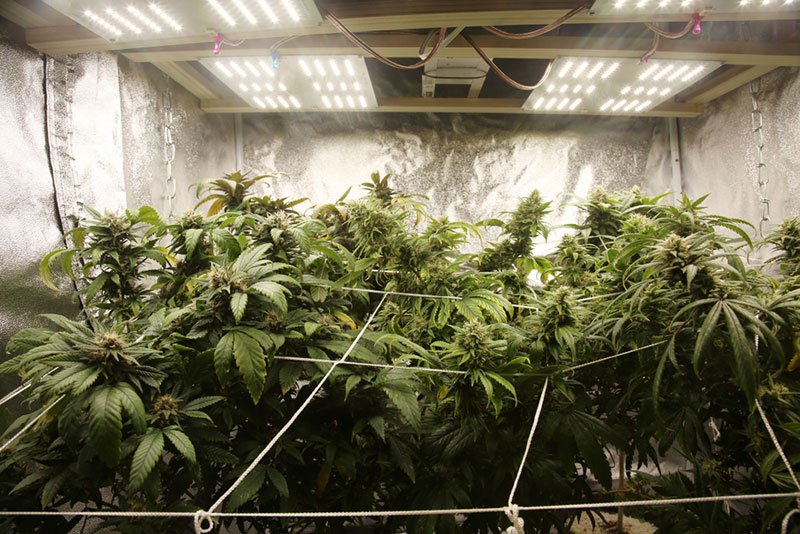
The main difference between a grow tent and a greenhouse is their size. A grow tent is smaller than a greenhouse and can be set up in virtually any indoor space, including spare rooms, garages, or basements. Greenhouses are usually larger structures and are typically used for commercial farming or by serious hobbyists.
Grow tents provide a completely controlled environment for plant growth, enabling you to regulate temperature, humidity, light, and other factors like CO2 levels. Greenhouses offer climate control but are not as easily regulated as grow tents.
Grow tents are portable and easy to assemble and disassemble, making them ideal for growers who may need to move their setup. At the same time, greenhouses are usually permanent structures requiring a dedicated outdoor space.
Do Grow Tents Use a Lot of Electricity?
Yes, grow tents use electricity, but the amount can vary widely depending on the components you use in tents, such as lights, ventilation, dehumidifiers, heaters/coolers, CO2 regulators, etc.
For instance, if you’re using LED lights, they are more energy efficient than HID or HPS, reducing overall costs. They use 10-100 watts of electricity per hour. So, if an LED light is rated at 50 watts, it will consume 50 watts of electricity in one hour. Running this light for 24 hours would consume 1,200 watts or 1.2 kilowatt-hours (kWh) daily. Over a month (30 days), it would consume 36 kWh; over a year (365 days), it would consume 438 kWh. The grow light consumes between 400 and 650 watts to achieve a satisfactory harvest.
Fans are used to control temperature and provide fresh air. Their power usage depends on their size and how often they run, so in a standard 4ft x 4ft tent, the extraction fan, circulation fan, and water or air pumps typically use about 15 to 30 watts each, totaling around 70 watts per hour.
If you’re using a dehumidifier, it will also consume electricity. Its power usage will depend on its size, and how often it runs, so a small 30-pint dehumidifier uses 300W of energy per hour. Running this dehumidifier continuously for 24 hours would consume 7.2 kilowatt-hours (kWh) daily. Over a month (30 days), it would consume 216 kWh; over a year (365 days), it would consume 2,628 kWh.
If you’re using additional heaters/coolers, they also contribute to your electricity usage. An electric model consumes around 600W or more, while a smaller option, like a mini oil-filled radiator, could use about 700 watts.
CO2 regulators use less electricity as their primary function is to control CO2 levels.
To calculate the electricity consumption of a specific setup, you would need to know the wattage of each component and how many hours per day it runs. For example, if you have a 2×4 grow tent with a 400W LED light that runs for 18 hours per day, an exhaust fan that uses 50W and runs for 24 hours per day, and a dehumidifier that uses 200W and runs for 10 hours per day, you would calculate as follows:
(400W * 18h) + (50W * 24h) + (200W * 10h) = 7200Wh + 1200Wh + 2000Wh = 10400Wh per day
To convert this to kilowatt-hours (kWh), which is the unit most electricity bills use, divide by 1000:
10400Wh / 1000 = 10.4kWh per day
So, this setup would use approximately 10.4 kWh per day or about 312 kWh per month.
The amount of electricity a grow tent uses can increase or decrease depending on factors like the season (you might need more heating in winter and more cooling in summer), the specific needs of your plants (some plants, such as tomatoes, orchids, cucumbers require more light than other), and how well insulated your grow tent is.
To save energy, consider using LED lights, which are more efficient than other types of grow lights, and try to optimize your setup to use as little heating and cooling as possible. For example, you might place your grow tent in an area of your home that naturally stays warmer or cooler or insulate it better to reduce heat loss.
What Can You Grow in a Grow Tent?
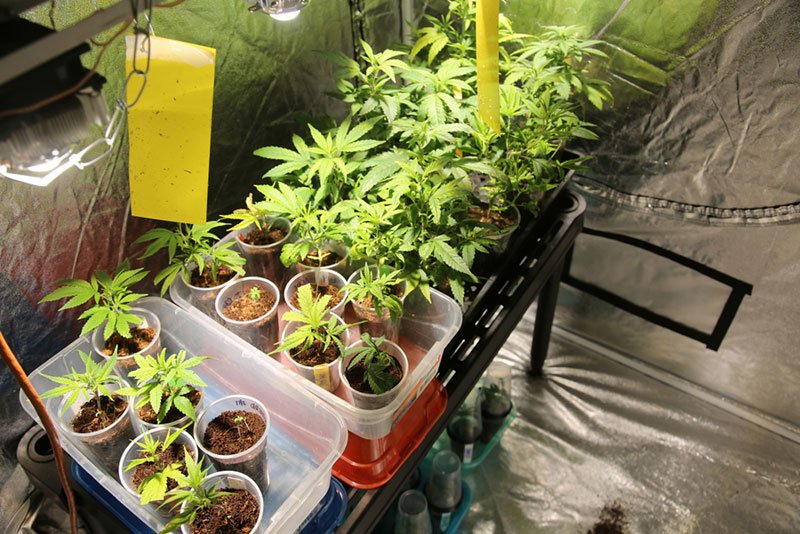
In a grow tent, you can grow tomatoes, bell peppers, cannabis, eggplant, broccoli, cauliflower, cabbage, herbs, celery, and small fruiting plants – strawberries, blueberries, etc. All these plants require a controlled indoor environment, so they are suitable for growing tent conditions.
Where to Buy a Grow Tent?
You can buy grow tents both online and in local stores.
- Home Depot: They offer free shipping on qualified Grow Tents products; you can pick them up in-store.
- Amazon: You can find various brands of Grow Tents on Amazon, including the iPower Grow Tent.
- Walmart: They offer Grow Tents & Accessories in their Hydroponics section.
- Gorilla Grow Tent: Known for their tall, thick, and sturdy indoor hydroponic and soil grow tents.
- Hydrobuilder: They have the largest selection of grow tents and grow tent accessories at competitive prices.
- LED Grow Lights Depot: They offer free shipping and no sales tax in the USA on their grow tents.
- eBay: Offers a wide range of Grow Tents for Hydroponics.
- The Bud Grower: They sell indoor growing tents made specifically for their kits.
- HTG Supply: They have many affordable grow tents for indoor gardening.
- Trimleaf: Offers a selection of high-quality grow tents for hobbyists and small-scale businesses.
- Contact manufacturers or suppliers who offer these options directly may be best for bulk or customized sizes. Some online platforms, such as Alibaba, cater to bulk and customized orders.
